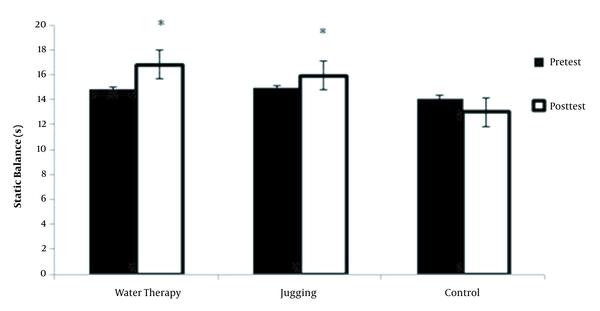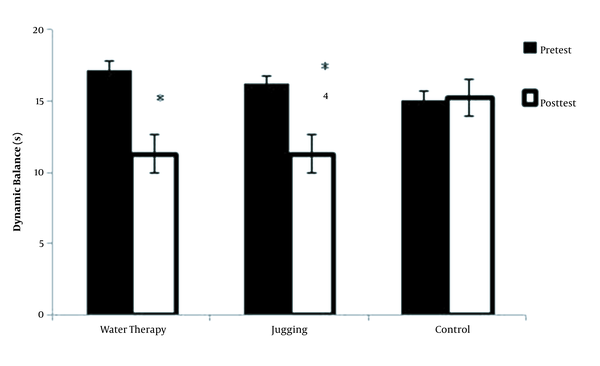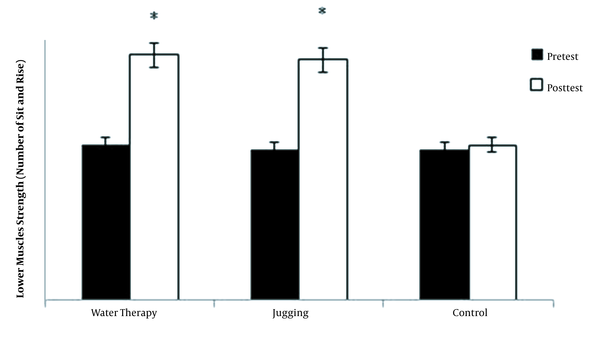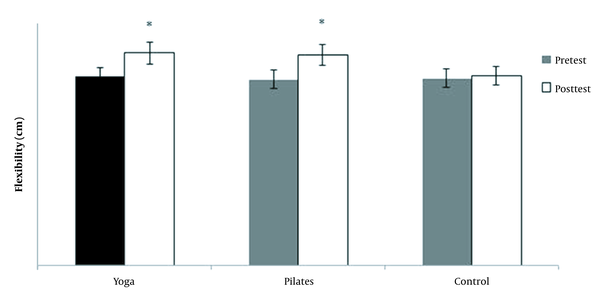Abstract
Objectives:
The aim of this research was to study the effects of a course of water therapy and jogging on factors related to the physical fitness of elderly women.Methods:
Semi experimental study was performed by pretest-posttest design in which elderly women over 60 (64.3 ± 2.5 years old) were randomly divided into 3 groups of water therapy exercises, jogging group (JG) and control group (CG). Factors related to physical fitness (lower limb muscle strength test, static balance, dynamic balance and physical flexibility) before and after interventional exercises. One-way ANOVA and Tukey's post hoc test were applied to analyze the data.Results:
It was shown that both water therapy exercises and jogging had a significant effect on static (P = 0.03), dynamic (P = 0.04), lower limb strength [P = 0.03 and (P = 0.01) for WTE and JG, respectively] and physical flexibility scores (P = 0.03), but there was no significant difference between the two experimental groups in all research variables (P ≥ 0.05).Conclusions:
The use of water therapy and jogging exercises leads to improved static and dynamic balance, muscular strength of the lower extremities. Since improving the motor performance variables has a significant effect on preventing the falling of the elderly, it is recommended to use these exercises for the elderly.Keywords
Water Therapy Jogging Flexibility Muscle Strength Dynamic Balance Static Balance
1. Background
Elderly is a stage in which the physiological and mechanical performance of the body diminishes and the cardiovascular function gradually decreases (1-3). Research has shown that early aging is accelerated by immobility (4, 5). Therefore, one of the most important ways to increase adaptability in the elderly is to improve mobility. Aging is a period that is associated with erosive and degenerative changes in many physical and physiological systems in the human body (1, 6, 7). Falling is one of the most worrying issues that often occurs in the elderly (8, 9). Approximately 30% of people over 65 years of age drop at least once and 15% yearly twice or more (10). Therefore, in order to prevent falling, it is necessary to activate anti-gravity muscles by creating special conditions and stimulate the body balance (11). Based on the evidence, improving muscle mass and strength, balance, and increasing physical flexibility can help improve elderly motor function and avoid falling (6, 12). It has been revealed that elderly people can adapt to physical activity and develop or improve their work capacity, and in some cases, they can be compared with that of young people. Elderly people are not able to perform any kind of activity due to some physiological, physical and motor restrictions (13, 14). Therefore, the necessity of planning the appropriate training program becomes more pronounced due to their physical condition. Simonsick et al. (2005) stated that the strength of the sagittal thigh muscles plays a major role in maintaining balance and stability in older adults. Therefore, reduction in muscle mass and weakness in the sensory motor system reduce the balance and stability while walking. Therefore, the use of appropriate therapeutic methods is necessary to improve balance and postural control to prevent the risk of falling (5). Recently, the effectiveness of relaxation exercises, including water therapy and walking, has been considered by researchers in the elderly. These exercises are a combination of physical mental exercises focused on controlling movements, positioning and breathing. These training methods emphasize factors such as flexibility, power and balance (15). The logic of using relaxation exercises such as water therapy and jagging and comparing them in this study is due to the interest of the elderly in these activities (15).
2. Objectives
In order to improve the quality of life of the elderly prevent the damage caused by the fall, the purpose of this research was to investigate the influence of water therapy and jogging exercises on factors related to physical fitness in elderly women.
3. Methods
This quasi experimental study was carried out using pretest-posttest design in which elderly women over 60 (64.3 ± 2.5 years old) were randomly divided into 3 groups of water exercises, jagging and control group. All subjects were asked to sign the consent form before the study. Factors related to physical fitness (lower limb muscle strength test, static balance, dynamic balance and physical flexibility) were evaluated before and after sports interventions. The inclusion criteria were: BMI > 25, waist-hip ratio > 90%, visceral fat > 90 cm2. All body composition variables were measured using the body composition analyzer ZEUS 9.3. In the pretest stage, motor function variables (BMI, static balance, dynamic balance and physical flexibility), and body composition (amount of muscle, body fat percentage) were measured using body composition analysis (ZENUS 9.9 model) (1). Physical fitness tests include lower limb muscle strength, static balance, dynamic balance and physical flexibility. The stork test was used to measure static equilibrium in seconds and one hundredth of a second. In this test, the elder stood on the sole of top foot and placed the other foot on the inner side of the knee so that the fingers are completely down and the hands are placed on the iliac crest on both sides and with marking the examiner, the subject raised the heel of top foot above the ground and kept her balance as far as she could. During the maintenance of the balance, the top foot should never be displaced from their original position. Flexibility testing was performed with Wells test. The subject sat on the floor with her legs thoroughly pulled up and leaned her legs to the flexible box, and the body flexed forward without bending the knees with the help of the fingertips of both hands the lever moved on the box forward and bended forward as far as possible. In this test, bending forward was carried out without any knocking movements. The degree of bending on the graded ruler was measured in cm. Test up and down the stairs for dynamic balance measurements in this test, the subjects go up and down seven times from a chair with an elevation of 20 centimeters. The person goes up one step further and then takes the other foot up the chair. Then lower the first leg and eventually lower the other foot. Each time it is repeated, it is considered as one. When the subject performed this seven times, a record was recorded (16).
3.1. Standing Seat Test
Used for measuring strength of lower muscles and legs. The subject, while sitting at the edge of a chair, needs to stand up to 30 seconds and return to the sitting position again. The average frequency of this movement in two 30-second cycles is considered to be the final record. The reliability of test has been reported 92.9 and 0.84 for males and females respectively (16). One-way ANOVA and Tukey's post hoc test were used to analyze the data. The participants were explained about research procedure and signed the consent form. The research was approved by ethical committee of Qazvin University of Medical Sciences (IR.QUMS.REC.1397.324).
4. Results
Demographic characteristics of participants are observed in Table 1.
| Groups | AE (n = 10) | AC (n = 9) | DE (n = 10) | P Value |
|---|---|---|---|---|
| Age (y) | 64.2 ± 2.1 | 64.3 ± 2.8 | 64.5 ± 4.2 | 0.20 |
| BMI (kg/m2) | 31.57 ± 1.14 | 30.71 ± 0.54 | 30.60 ± 0.57 | 0.51 |
| WHR (ratio) | 0.93 ± 0.05 | 0.93 ± 0.06 | 0.92 ± 0.07 | 0.08 |
| BFP (%) | 31.36 ± 4.12 | 32.11 ± 6.55 | 31.47 ± 4.34 | 0.05 |
As the results of one-way ANOVA are shown in Table 2, there is a significant difference between the amount of total muscle, body fat percentage, and muscle and fat in the left and right legs of the groups. As you can see, water therapy and jagging training interventions significantly reduced the percentage of body fat and fat in the left and right legs while increasing the total muscle of the body and the muscles of the left and right legs.
Body Composition Data Before and After Intervention
| Variables/Groups | Water Therapy | Jogging | Control | P Value | |||
|---|---|---|---|---|---|---|---|
| Pretest | Posttest | Pretest | Posttest | Pretest | Posttest | ||
| Muscles | |||||||
| Total body weight (kg) | 24.8 ± 1.1 | 25.3 ± 1.2 | 25.3 ± 1.3 | 26.4 ± 1.2 | 25.2 ± 0.8 | 25.4 ± 0.2 | 0.03 |
| Right leg (kg) | 5.8 ± 0.5 | 6.2 ± 0.2 | 5.9 ± 0.3 | 6.3 ± 0.4 | 5.9 ± 0.3 | 6.0 ± 0.3 | 0.02 |
| Left leg (kg) | 5.5 ± 0.4 | 5.9 ± 0.3 | 5.4.0 ± 0.3 | 5.9 ± 0.3 | 6.0 ± 0.5 | 6.1 ± 0.4 | 0.04 |
| Fat | |||||||
| Percentage body fat (%) | 28.3 ± 1.1 | 26.3 ± 1.2 | 31.4 ± 1.0 | 29.8 ± 1.4 | 29.4 ± 1.2 | 30.0 ± 1.1 | 0.01 |
| Right leg (kg) | 2.8 ± 0.4 | 2.4 ± 0.3 | 2.9 ± 0.2 | 2.6 ± 0.5 | 3.1 ± 0.5 | 3.0 ± 0.2 | 0.03 |
| Left leg (kg) | 2.9 ± 0.5 | 2.4 ± 0.3 | 3.0 ± 0.2 | 2.6 ± 0.6 | 3.0 ± 0.4 | 3.0 ± 0.3 | 0.02 |
As shown in Figure 1, there is a significant difference between the experimental and control groups (P ≤ 0.05). Tukey's test results showed that the static equilibrium scores in the experimental group of water therapy (P = 0.03) and jagging (P = 0.03) were significantly better than the control group, but there was no significant difference between the two experimental groups.
Comparison of static balance between experimental and control groups

As shown in Figure 2, there is a significant difference of dynamic balance between the experimental and control groups (P ≤ 0.05). Tukey's test results showed that the dynamic balance test scores in the experimental group of water therapy (P = 0.04) and jagging (P = 0.04) were significantly better than the control group, but there was no significant difference between the two experimental groups.
Comparison of dynamic balance between experimental and control groups

As shown in Figure 3, there is a significant difference between the lower muscle strength of the experimental and control groups (P ≤ 0.05). The results of the Tukey test showed that the lower strength muscle strength scores in the experimental groups of water therapy (P = 0.001) and jagging (P = 0.003) were significantly better than the control group.
Comparison of lower muscle strength between experimental and control groups

As shown in Figure 4, there is a significant difference between the flexibility of the experimental groups and the control. The test results revealed that physical flexibility test scores in the experimental group water therapy (P = 0.03) and jogging (P = 0.03) is significantly better than the control group.
Comparison of flexibility between experimental and control groups

5. Discussion
Given the importance of falling prevention in older adults, the effects of aquatic and jogging exercises on some physical indices were evaluated. As shown, motor function tests including static and dynamic balance, lower limb muscle strength and physical flexibility were significantly improved after water therapy and jogging exercises. As shown in Table 1, the total muscle mass, right and left leg muscles of the experimental groups significantly increased, which is a factor in the increase of muscular strength of the lower limb, which can affect the static and dynamic equilibrium. These results are consistent with findings of the Lambrinides (2009), Leigh et al. (2012), Bergamin & Associates (2012) (10, 17, 18) which suggested that postural control can be improved by exercise programs. Changes in body composition (muscle gain and fat loss) that occur as a result of physical activity can be effective in maintaining balance with the ease of use of the muscular nervous system (6, 19). One of the possible reasons for improving balance can be attributed to the increase in neurological fitness created by exercise. reorganization in the sensory cortex, increased efficiency and synaptic communication power, increased nervous system activation, decreased neural inhibitory reflexes, decreased neurotransmitter resistance to transmission impulse, improvement are some more reasons. Additionally, water therapy and jogging exercises by stimulating the senses involved in equilibrium provide conditions for challenging the balance can be effective in improving the balance of elderly people. These results are not in line with the results of Dung Cock et al. (2008), Cramwell et al. (2007), which did not report significant differences in balance scores following the practice protocol. The probable reasons for this contradiction can be the duration of the training period in the present study and the difference in the nature of the exercise protocol was attributed to two studies. Another possible reason is the difference in the number and status of the subjects in the two studies which in the study by Dong Cock et al., 25 patients had a history of brain stroke but in present study subjects were healthy elderly women. Cheng et al. (2004) concluded that performing activities such as walking, yoga, aerobics and stretching can reduce motor problems such as falling. As the age increases, the flexibility of the body decreases, one of the effective ways to avoid falling elderly is to increase physical flexibility. On the other hand, the results of this study are consistent with the study by Deborah Turkl and colleagues (1997) that elderly can greatly increase muscle strength and speed through resistive exercises, because the velocity and power of the two components are those that direct the dynamic equilibrium affect. As a result, physical exercises for water therapy and jogging, focusing on movement control, body position and respiration, can increase factors such as flexibility, strength and balance and improve elderly motor performance. One of the limitations of this study was the gender of the subjects, in which only older women were recruited, and men can be used in future research. Because psychological factors such as fear, anxiety, stress, depression, and self-esteem decline with age, the role of these factors should be considered in future research.
5.1. Conclusion
As the results of the study showed that physical flexibility was significantly increased in the two groups of water therapy and jogging, the necessity of using these exercises in the elderly was more necessary. A large part of the water therapy and jogging exercises are focused on movements that are performed to enhance balance, strength and flexibility. Therefore, improving the balance and flexibility of the experimental group seems to be evident. Reducing power, flexibility, strength and muscular endurance will all help to change the patterns of gait.
Acknowledgements
References
-
1.
Taheri M, Irandoust K. The effects of weight-loss induced aerobic exercise on depressive symptoms in the elderly. Int J Sport Stud. 2014;3(5):295-8.
-
2.
Amini M, Mirmoezzi M, Salmanpour M, Khorshidi D. Effect of 8-week of selected aerobic exercises on improving the quality of life in healthy aged sedentary men. Int J Sport Stud Hlth. 2018;1(1). e67514. https://doi.org/10.5812/intjssh.67514.
-
3.
Rodrigues-Rodrigues T, Claudia Vieira Gomes A, Rodrigues Neto G. Nutritional status and eating habits of professors of health area. Int J Sport Stud Hlth. 2017;1(1). e64335. https://doi.org/10.5812/intjssh.64335.
-
4.
Kimura T, Kobayashi H, Nakayama E, Hanaoka M. Effects of aging on gait patterns in the healthy elderly. Anthropol Sci. 2007;115(1):67. https://doi.org/10.1537/ase.060309.
-
5.
Simonsick EM, Guralnik JM, Volpato S, Balfour J, Fried LP. Just get out the door! Importance of walking outside the home for maintaining mobility: Findings from the women's health and aging study. J Am Geriatr Soc. 2005;53(2):198-203. [PubMed ID: 15673341]. https://doi.org/10.1111/j.1532-5415.2005.53103.x.
-
6.
Irandoust K, Taheri M. The effects of aquatic exercise on body composition and nonspecific low back pain in elderly males. J Phys Ther Sci. 2015;27(2):433-5. [PubMed ID: 25729184]. [PubMed Central ID: PMC4339154]. https://doi.org/10.1589/jpts.27.433.
-
7.
Taheri M, Irandoust K. The effect of omega3 supplementation and functional exercises on psychomotor performance of aged women in Qazvin. Int J Environ Res. 2018;16(22):4387. https://doi.org/10.32598/sija.13.10.100.
-
8.
Irandoust K, Taheri M, Mirmoezzi M, H'Mida C, Chtourou H, Trabelsi K, et al. The effect of aquatic exercise on postural mobility of healthy older adults with endomorphic somatotype. Int J Environ Res Public Health. 2019;16(22). [PubMed ID: 31717625]. [PubMed Central ID: PMC6888232]. https://doi.org/10.3390/ijerph16224387.
-
9.
Taheri M, Mirmoezzi M, Sabaghi M. [Effects of aquatic on balance and preventing of fall among healthy elderly men]. J Saf Promot Inj Prev. 2018;6(3):144-51. Persian.
-
10.
Hale LA, Waters D, Herbison P. A randomized controlled trial to investigate the effects of water-based exercise to improve falls risk and physical function in older adults with lower-extremity osteoarthritis. Arch Phys Med Rehabil. 2012;93(1):27-34. [PubMed ID: 21982325]. https://doi.org/10.1016/j.apmr.2011.08.004.
-
11.
Laughton CA, Slavin M, Katdare K, Nolan L, Bean JF, Kerrigan DC, et al. Aging, muscle activity, and balance control: Physiologic changes associated with balance impairment. Gait Posture. 2003;18(2):101-8. [PubMed ID: 14654213]. https://doi.org/10.1016/s0966-6362(02)00200-x.
-
12.
Seghatoleslami A, Hemmati Afif A, Irandoust K, Taheri M. [Effect of pilates exercises on motor performance and low back pain in elderly women with abdominal obesity]. Iran J Ageing. 2018;13(3):396-404. Persian. https://doi.org/10.32598/sija.13.3.396.
-
13.
Chodzko-Zajko WJ, Proctor DN, Fiatarone Singh MA, Minson CT, Nigg CR; American College of Sports Medicine, et al. American college of sports medicine position stand. Exercise and physical activity for older adults. Med Sci Sports Exerc. 2009;41(7):1510-30. [PubMed ID: 19516148]. https://doi.org/10.1249/MSS.0b013e3181a0c95c.
-
14.
Irandoust K, Taheri M. The effect of strength training on quality of sleep and psychomotor performance in elderly males. Sleep Hypn. 2017;20(3):160-5. https://doi.org/10.5350/Sleep.Hypn.2017.19.0148.
-
15.
Smith K, Smith E. Integrating pilates-based core strengthening into older adult fitness programs. Top Geriatr Rehabil. 2005;21(1):57-67. https://doi.org/10.1097/00013614-200501000-00007.
-
16.
Jones CJ, Rikli RE, Beam WC. A 30-s chair-stand test as a measure of lower body strength in community-residing older adults. Res Q Exerc Sport. 1999;70(2):113-9. [PubMed ID: 10380242]. https://doi.org/10.1080/02701367.1999.10608028.
-
17.
Ryushi T, Kumagai K, Hayase H, Abe T, Shibuya K, Ono A. Effect of resistive knee extension training on postural control measures in middle aged and elderly persons. J Physiol Anthropol Appl Human Sci. 2000;19(3):143-9. [PubMed ID: 10924038]. https://doi.org/10.2114/jpa.19.143.
-
18.
Bergamin M, Zanuso S, Alvar BA, Ermolao A, Zaccaria M. Is water-based exercise training sufficient to improve physical fitness in the elderly? Eur Rev Aging Phys Act. 2012;9(2):129-41. https://doi.org/10.1007/s11556-012-0097-1.
-
19.
Irandoust K, Taheri M, Neto GR, Lotfi L. Physical and physiological literacy feedback improves the exercise behavior in TOFI governors and chief executive officers. J Exerc Physiol. 2017;20(6):24-30.

.jpeg)